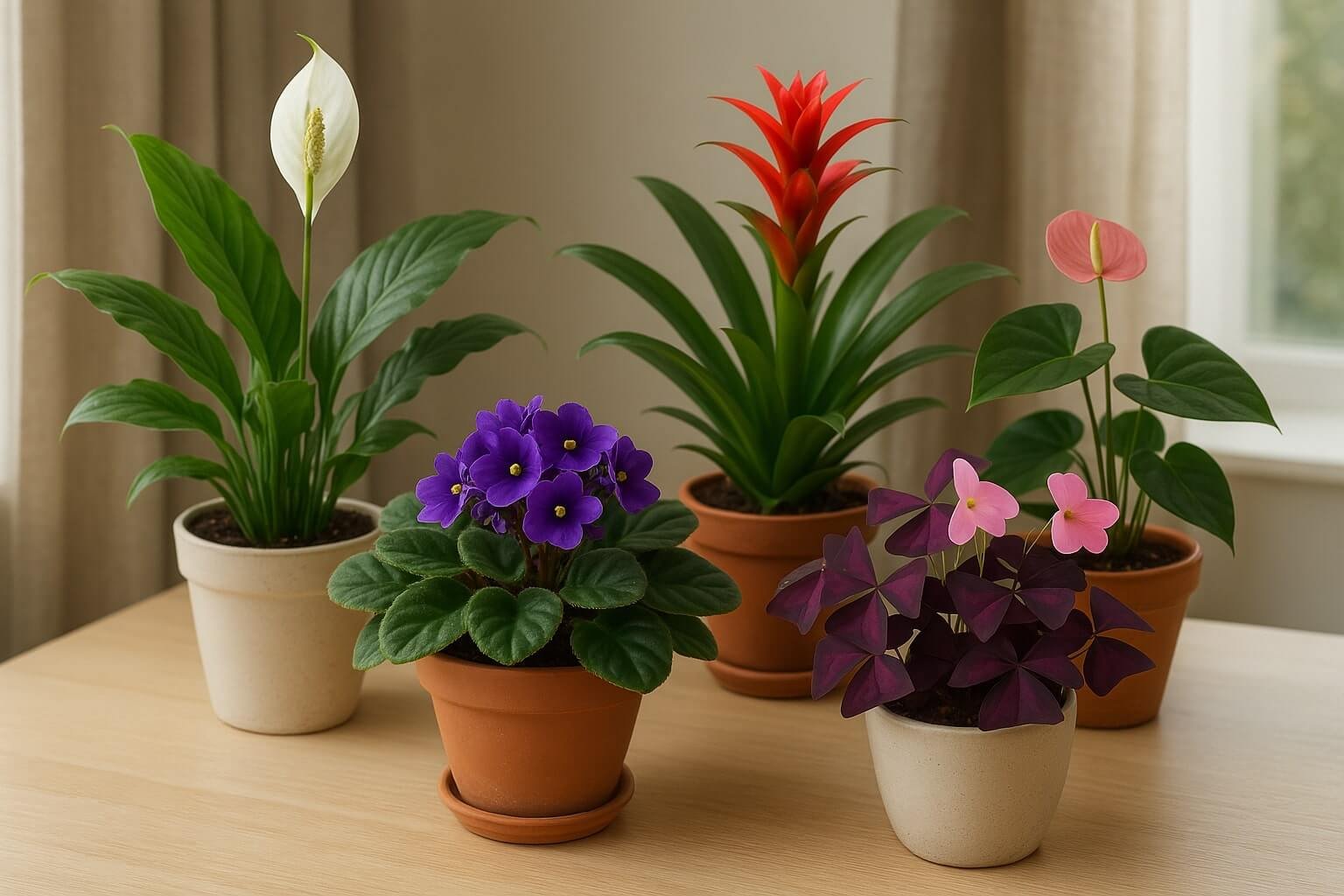Introduction
Not every home is blessed with abundant sunlight—but that doesn’t mean you have to sacrifice greenery or floral charm. Whether you live in a cozy apartment or have shaded corners in your house, there are indoor flowers that thrive in low light and still offer vibrant blooms and lush foliage. In this guide, we’ll explore the best indoor flowering plants for low light conditions, how to care for them, and why they’re perfect for your space.
🌿 Why Choose Low Light Indoor Flowers?
- Adaptability: These plants flourish in shaded rooms, hallways, or north-facing windows.
- Low Maintenance: Most require minimal watering and care.
- Air Purification: Many double as natural air filters.
- Mood Boosters: Flowers add color, texture, and emotional warmth to any room.
🌼 Top 10 Indoor Flowers That Thrive in Low Light
1. Peace Lily (Spathiphyllum)
- Light Needs: Low to moderate indirect light
- Bloom: Elegant white spathes
- Care Tip: Water when leaves droop slightly
2. African Violet (Saintpaulia)
- Light Needs: Filtered light or fluorescent lighting
- Bloom: Purple, pink, or white flowers
- Care Tip: Keep soil moist but not soggy
3. Bromeliads
- Light Needs: Indirect light or fluorescent light
- Bloom: Bright red, orange, or pink bracts
- Care Tip: Water in the central cup, not the soil
4. Lipstick Plant (Aeschynanthus radicans)
- Light Needs: Low to medium light
- Bloom: Red tubular flowers
- Care Tip: Let soil dry slightly between watering
5. Kalanchoe (Kalanchoe blossfeldiana)
- Light Needs: Indirect light
- Bloom: Clusters of red, orange, yellow, or pink
- Care Tip: Allow soil to dry between watering
6. Oxalis (Purple Shamrock)
- Light Needs: Low light with occasional bright exposure
- Bloom: Delicate pink or white flowers
- Care Tip: Goes dormant seasonally—don’t panic!
7. Anthurium (Flamingo Flower)
- Light Needs: Low to medium indirect light
- Bloom: Glossy red or pink spathes
- Care Tip: Mist regularly for humidity
8. Cyclamen
- Light Needs: Cool, indirect light
- Bloom: Star-shaped flowers in pink, red, or white
- Care Tip: Water from the bottom to avoid rot
9. Clivia (Kaffir Lily)
- Light Needs: Low light during dormancy, moderate during bloom
- Bloom: Trumpet-shaped orange or yellow flowers
- Care Tip: Keep root-bound for better flowering
10. Guzmania Bromeliads
- Light Needs: Low light or artificial light
- Bloom: Vibrant central flower spike
- Care Tip: Replace water in the central cup weekly
🪴 Tips for Growing Indoor Flowers in Low Light
- Use Reflective Surfaces: Mirrors and light-colored walls help bounce light.
- Rotate Plants: Ensure even growth by rotating pots weekly.
- Supplement with Grow Lights: LED grow lights can mimic sunlight.
- Avoid Overwatering: Low light slows evaporation—check soil before watering.
- Choose the Right Potting Mix: Well-draining soil prevents root rot.
🌟 Styling Ideas for Low Light Flowering Plants
- Floating Shelves: Display trailing plants like Lipstick Plant or Oxalis.
- Terrariums: African Violets and Peace Lilies thrive in humid glass containers.
- Bathroom Decor: Anthuriums and Bromeliads love the humidity.
- Entryway Charm: Clivia or Cyclamen add a welcoming pop of color.
❓ Frequently Asked Questions (FAQs)
Q1: Can flowering plants really survive in low light?
A: Yes! Many indoor flowers like Peace Lily, African Violet, and Bromeliads are adapted to thrive in shaded environments.
Q2: How often should I water low light indoor flowers?
A: Most prefer slightly moist soil. Water when the top inch feels dry, but avoid soggy conditions.
Q3: What’s the easiest low light flowering plant for beginners?
A: Peace Lily and Kalanchoe are great starter options—they’re forgiving and bloom reliably.
Q4: Do these plants need fertilizer?
A: Yes, but sparingly. Use a balanced liquid fertilizer once a month during the growing season.
Q5: Are low light flowering plants safe for pets?
A: Some, like Peace Lily and Anthurium, can be toxic. Always check plant safety before placing them in pet-accessible areas.





